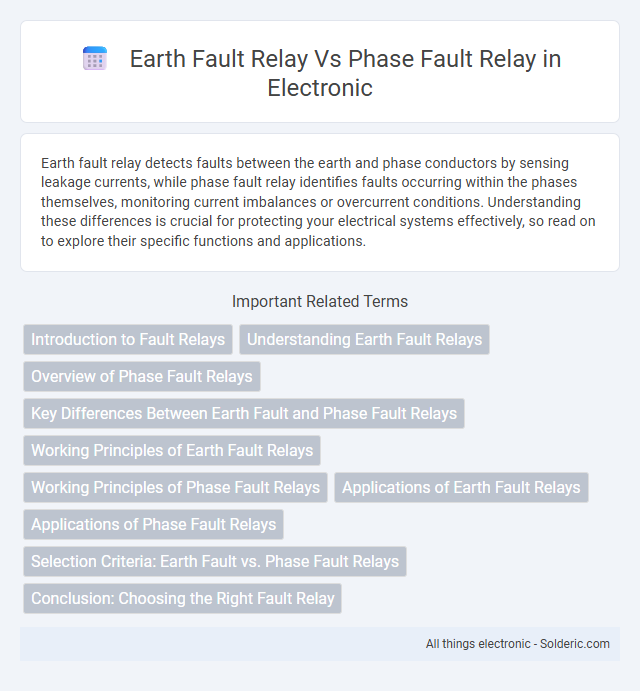Earth fault relay detects faults between the earth and phase conductors by sensing leakage currents, while phase fault relay identifies faults occurring within the phases themselves, monitoring current imbalances or overcurrent conditions. Understanding these differences is crucial for protecting your electrical systems effectively, so read on to explore their specific functions and applications.
Comparison Table
| Feature | Earth Fault Relay | Phase Fault Relay |
|---|---|---|
| Function | Detects faults between earth and any phase conductor | Detects faults between phases (phase-to-phase faults) |
| Fault Type | Earth/ground faults | Phase faults (short circuit between phases) |
| Sensitivity | Highly sensitive to leakage currents to earth | Detects high current due to short circuit between phases |
| Sensing Method | Monitors residual current or zero-sequence current | Measures phase currents and phase angle differences |
| Usage | Protects against grounding faults to prevent equipment damage | Protects against short circuits and phase faults to avoid system failure |
| Typical Setting | Lower current threshold (mA to A range) | Higher current threshold, typically close to rated current |
| Location | Connected to neutral or ground reference | Connected to phase lines |
Introduction to Fault Relays
Earth fault relays detect ground faults by measuring leakage currents to earth, protecting electrical systems from insulation failures. Phase fault relays monitor phase-to-phase faults by sensing abnormal current imbalances in the system's phases. Your selection between these relays depends on the specific type of fault protection required in your electrical network.
Understanding Earth Fault Relays
Earth fault relays detect ground faults by monitoring leakage currents flowing to the earth, providing critical protection against insulation failures in electrical systems. They operate based on sensing residual current or voltage imbalance between phase conductors and earth, enabling quick isolation of faulty sections to prevent damage and ensure safety. Phase fault relays, in contrast, primarily protect against phase-to-phase faults by detecting abnormal current or voltage conditions between phase conductors.
Overview of Phase Fault Relays
Phase fault relays detect abnormalities such as short circuits or open circuits within individual phase conductors, ensuring protection against phase-to-phase faults. These relays monitor current imbalances and phase deviations to prevent equipment damage and maintain system stability. Your electrical system benefits from timely isolation of faulty phases, minimizing downtime and enhancing operational safety.
Key Differences Between Earth Fault and Phase Fault Relays
Earth fault relays detect current leakage to ground, providing protection against insulation failures by sensing low-magnitude fault currents, while phase fault relays monitor phase-to-phase faults characterized by high current levels within the system. Earth fault relays are sensitive to ground faults and operate based on residual current or zero-sequence current, whereas phase fault relays trigger on unbalanced current or voltage conditions during phase short circuits. Understanding these distinctions helps you select the appropriate relay type for safeguarding electrical installations from specific fault conditions.
Working Principles of Earth Fault Relays
Earth fault relays operate by detecting imbalance in the current between the phases and the neutral or earth, indicating leakage or fault current flowing to ground. They monitor residual current or zero-sequence current using current transformers to identify faults where current returns through the earth path. In contrast, phase fault relays detect abnormal current flow between the phases, responding to overcurrent conditions caused by phase-to-phase faults by measuring differential or phase currents.
Working Principles of Phase Fault Relays
Phase fault relays operate by continuously monitoring current levels in each phase of an electrical system to detect abnormalities indicative of phase faults, such as short circuits or overloads. These relays use current transformers to measure the instantaneous current and compare it against preset thresholds; if the current exceeds these limits, the relay triggers a trip signal to isolate the faulty phase. The working principle centers on rapid fault detection and protection, ensuring system stability by preventing damage from unbalanced or excessive phase currents.
Applications of Earth Fault Relays
Earth fault relays are primarily used in power systems to detect ground faults by sensing leakage currents to earth, preventing equipment damage and ensuring personnel safety in distribution and industrial networks. These relays are crucial for protecting transformers, generators, and cables against insulation failures and earth faults that can cause significant power outages or fire hazards. Your electrical protection scheme benefits from earth fault relays by enabling rapid fault isolation and minimizing downtime in systems with grounded neutral configurations.
Applications of Phase Fault Relays
Phase fault relays are primarily used in protecting electrical power systems from phase-to-phase faults, which can cause severe damage to motors, transformers, and generators by detecting abnormal current imbalances between phases. Your industrial and utility applications benefit from phase fault relays by ensuring quick isolation of faulty sections to prevent equipment damage and minimize outage times. These relays play a critical role in maintaining system stability and safety by promptly identifying phase faults that earth fault relays may not detect.
Selection Criteria: Earth Fault vs. Phase Fault Relays
Selecting between earth fault and phase fault relays depends on the specific protection needs of your electrical system. Earth fault relays detect ground faults by monitoring leakage currents to earth, making them crucial for protecting insulation integrity and preventing equipment damage. Phase fault relays, on the other hand, identify short circuits between phases and are essential for safeguarding circuits against phase-to-phase faults and ensuring system stability.
Conclusion: Choosing the Right Fault Relay
Earth fault relays detect ground faults by sensing current leakage to earth, ensuring rapid disconnection to prevent equipment damage and hazards. Phase fault relays monitor current imbalances or excessive current in phase conductors, protecting against short circuits and overloads in three-phase systems. Your choice between earth fault and phase fault relays depends on the specific protection requirements of your electrical system, emphasizing the importance of selecting the relay that best targets the fault type to enhance safety and reliability.
earth fault relay vs phase fault relay Infographic

 solderic.com
solderic.com